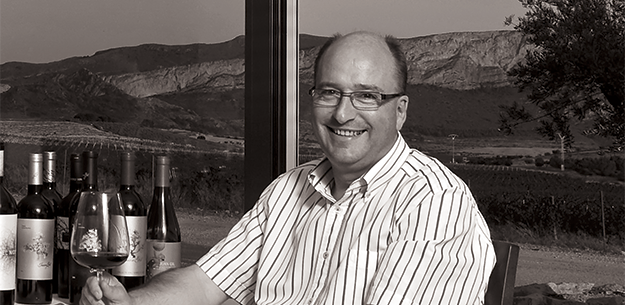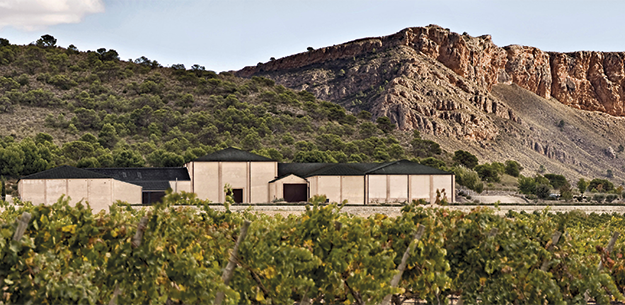.png.transform/rendition-xs/image_image%20(1).png)
Juan Gil Winery: A Century and a Wine
Juan Gil 100th anniversary. Behind the wine of the centennial, an expansion in the last 12 years with 10 cellars in eight Designations of Origin (DO). Its success: an unbeatable quality-price ratio. From the Murcian town of Jumilla, its wines rub shoulders with big leagues of Spain and conquer the world.
Text: Maricar de la Sierra / Club de Gourmets magazine

If I were to define this Murcian from Jumilla, I would laud his normality. Humble, discrete and beaming, this intelligent aeronautical engineer, who dreamed of designing planes, decided to go back to his roots by relaunching his great-grandfather's cellar. So, one century and four generations later, Miguel Gil takes his first strategic leap in 2001, with a new cellar and the Monastrell variety as protagonist. Reorganizing the company under the name Hijos de Juan Gil, the 9 brothers establish Gil Family States in 2002.
The success of El Nido was immediate, with the best ratings in all guides worldwide. In the 2016 Gourmet Wine Guide, El Nido 2012 scores 98/100 points; its younger sibling, Clío, 97/100; and Juan Gil 18 months, 96/100. Then, the expansion kicks off. They search for almost unknown vineyard areas of great potential, with old vineyards of autochthonous varieties, where they produce high-quality wines at very competitive prices. The first was Can Blau, of the Montsant DO; then Ateca, in Calatayud; in 2007, Atalaya is born in Almansa; the following year Tridente, in Zamora; and Shaya in Rueda. In Rías Baixas, the Albariño Lagar da Condesa. The construction of Morca, in Campo de Borja, begins in 2014. The most recent project is a new cellar in Priorat. Total: 10 cellars in eight different DOs and 1,170 hectares of privately owned vineyards.
Its success, in figures, is a production of 8.2 million bottles, of which 75 percent are exported to more than 40 countries; a workforce of 150 employees and a turnover of 31 million euros in 2015. The personal achievement of this good man from Jumilla is that the entire family is involved.
If his great-grandfather were to lift his head up from the grave, he would be boggled.
He never would have imagined that his cellar would have survived for so long, as his profession was masonry. He established a cellar downtown because he had a passion for wines, but no knowledge. He would be surprises, but my father even more so. My father told us to not even consider continuing with the business, despite the fact that I would accompany him to the cellar every weekend. During vacations we'd go with him, too, and he involved us in all of the processes. That's how I started learning, from a very young age.
However, you decided to become an aeronautical engineer.
I liked the universe of wines a lot, but not chemistry, nor studying it. My father advised me to study something, something I liked with which I could earn a living, and said that if afterwards I wanted to dedicate myself to the family business that I could. That's what I did. I liked planes a lot and when I completed my university studies I worked for 9 years in Seville. But the seed of wines was deeply instilled in me. Therefore, my wife, also from Jumilla, and I, decided to return. The opportunity arose to work with García Carrión, which was undergoing professionalization, and I did not hesitate. Many people told me I was crazy. But, it helped me to learn and consider what I really wanted to do.
You broke the mold in Jumilla with El Nido and Clío.
I was familiar with many different regions in Spain, where those iconic wines we're all familiar are produced, but Jumilla also existed and I couldn't understand why we weren't capable of achieving something analogous. Therefore, we considered a project that was absolutely different from the Juan Gil cellar: that making a wine -even if it failed to generate profits for us- could demonstrate to the world that great things could be done in Jumilla. It wasn't at all easy. We must bear in mind that the Monastrell does not accept all types of elaborations. It's elaboration is quite peculiar, otherwise the wines are too difficult to drink. What I find interesting about the Monastrell, and we proved it with Clío, is its tantalizing sweetness without sugar that invites you to have some more, and has made this wine one those with highest demand worldwide.
However, we did not sidestep criticism.
Other called us arrogant, questioning what we thought we were doing, claiming that our wines would not last five years in a bottle. Yet, we were convinced that our wines had a long road ahead of them. Today you can taste the harvest from 2005 and its impressive, it's a year I like to compare with any other of the world's best wined from 2005. A couple of years ago, an American who had a wine club came to visit us, and would perform anonymous wine tasting of great wines from around the world to purchase the best for the American market, and El Nido always won. We have managed for people to put it on their tables because it gives them prestige. We have also had a surprise when ordering a Nido at the French Laundry in California and being charged 700 dollars, when it sells for 150 dollars at a US store.
When did you decide to take the plunge into other lesser known DOs?
The opportunity arose in 2004 in Montsant, where some friends had made an investment and were no longer interested in continuing, and we analyzed the project and decided to assume it. The same thing happened in 2005 with Ateca, in Calatayud. What's most important is that in 2007, though politicians didn't see it coming, we as business owners were certain that the crisis was coming. We realized that we needed to have the structure of a large company without being large. We started to diversify, with Almansa that same year; in 2008 with Rueda, in Zamora and that's how we set up a network of small cellars, through which we could control the vineyards, assure the quality of the wines, and survive with a mid-sized structure. That was our wise decision, and we got ourselves a network of distributors for those who already considered us important because we didn't have just one product, but several.
Your wines are known for an unbeatable quality-price ratio.
Our family's philosophy is to offer consumes the best possible at the lowest price possible. When faced with pricing any of our products, we do this thinking of when the company will reach mid size, we plan this for the mid-term, before five years and now ten, thinking of where the cellar will be during this period and the related costs. To assume this risk we must invest in consumers. We don't only need to pay for the cellar's structure and fixed assets, but also must invest in the market as an intangible asset.
From the beginning you clearly had the goal of exporting.
I always knew that the same effort is required to sell a container full of wine from Jumilla abroad than a pallet in Spain, and the approach was to make the company viable, at any cost. We must understand the problem in Jumilla in the 80s, when everything changed, the wines started losing their personality and became difficult to drink. The wines from Jumilla were hardly known in Spain and in the United States even less. Gradually, the prescriptors and specialized media began witnessing that with the new elaborations there were wines from Jumilla similar to a Bordeaux at ridiculous prices, and the consumer started to take sides with us. We managed to introduce ourselves and, in fact, today it's one of the best selling Spanish wines in the United States. Also in Germany, Switzerland, England, Lithuania, Ukraine...
Article originally published in the Club de Gourmets magazine (Spanish). Translation by Lionbridge /@ICEX.
Juan Gil Winery: A Century and a Wine



